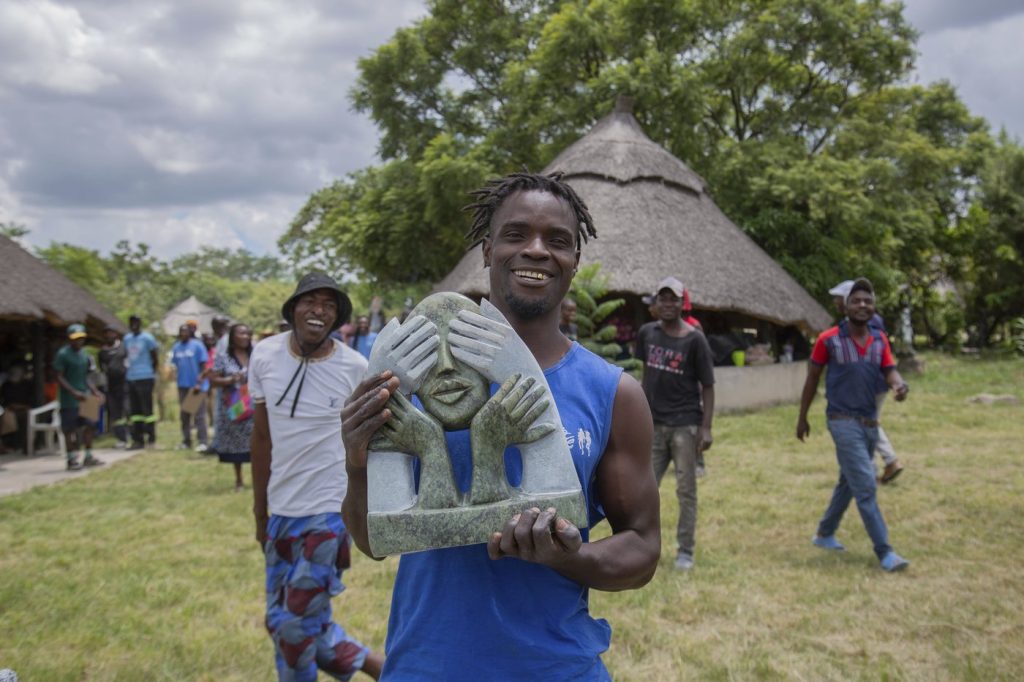CHITUNGWIZA, Zimbabwe (AP) – An upcoming exhibition at Oxford University will showcase poignant stone sculptures from Zimbabwe that contextualize the legacy of British imperialist Cecil John Rhodes. These works depict the brutal realities of colonialism, including religious deception, forced labor, and sexual abuse, with imagery ranging from "a pair of white hands blinding a Black face" to "a smiling colonizer with a Bible, crushing the skull of a screaming native." The exhibition intends to provoke thought and discussion regarding Rhodes' controversial legacy.
Rhodes was instrumental in the conquest of large parts of southern Africa in the late 19th century, amassing vast wealth through gold and diamond mining while appropriating land from indigenous populations. A statue of him still stands at Oriel College, Oxford, where he was a student and benefactor, leaving £100,000 (approximately £10.5 million today or $13.5 million) to the school. Despite ongoing protests against the statue since 2015, Rhodes’ influence persists, particularly through a scholarship funded by his endowment for students from southern African countries.
The exhibition, planned for September at Oriel College, is particularly significant for the Zimbabwean stone carvers at the Chitungwiza Arts Center near Harare. For them, this exhibition represents not only the chance to highlight a dark chapter in history for Western audiences but also an opportunity to revive an ancient but declining art form. Once a vibrant industry, Zimbabwean stone sculpture has faced significant challenges due to economic struggles and diminishing tourism.
Sculptor Wallace Mkanka expressed optimism about the exhibition's impact, stating, "This will boost business. Buyers abroad will now see our work and buy directly from the artists." His sculpture, which portrays the blinded Black face, was selected as the best among 110 entries and will be one of four winning pieces displayed in Oxford.
The name Zimbabwe translates to "House of Stone," reflecting the rich heritage stemming from the Great Zimbabwe ruins—an ancient Iron Age city recognized as a UNESCO World Heritage site. Stone sculpture has long served as a form of storytelling for Zimbabweans, capturing the essence of history and culture. This tradition endured colonial rule, which attempted to eradicate local art forms and customs.
Despite enduring a century of colonial threat, Zimbabwe's stone sculptures gained international attention, with thousands of pieces being appropriated and later becoming subjects of repatriation efforts. At one point, the sculpture industry thrived post-independence, with local and international buyers actively seeking these unique art pieces.
Tafadzwa Tandi, a 45-year-old sculptor whose work will be featured in the exhibition, recalled the prosperity of the industry: "Customers were everywhere. They would pay up front, and I always had a queue of clients." However, the past two decades have not been kind to the industry. Zimbabwe's international reputation was tarnished by the controversial land reforms that displaced over 4,000 white farmers, redistributing land to approximately 300,000 Black families. While late ruler Robert Mugabe defended these reforms as a means to address historical injustices, they had significant economic repercussions, including a drop in clientele for local artisans, as many white customers were affected by the reforms.
Tendai Gwaravaza, chairman of Chitungwiza Arts Center, noted that the loss of former clients was rooted in these land reforms: "Many of our customers were friends of the farmers. That is where the problem originated from." Currently, sculptors at Chitungwiza Arts Center are working diligently, with numerous finished pieces awaiting buyers, as heavy grinding sounds fill the air.
Gwaravaza emphasized the need for artists to actively seek markets and recognized the importance of the Oxford exhibition for offering much-needed exposure. The event is a creation of the Oxford Zimbabwe Arts Partnership, formed as a response to the "Rhodes Must Fall" campaign during the Black Lives Matter protests in the United States.
Initially envisioned as a larger project titled "Oxford and Rhodes: Past, Present, and Future," including enclosing Rhodes' statue in glass and installing bronze statues of African liberation fighters, the exhibition was scaled down due to financial constraints. Oriel College ultimately provided £10,000 for this more modest exhibition, a small start towards long-term goals, according to Richard Pantlin, the Oxford alumnus and co-founder of the Oxford Zimbabwe Arts Partnership.










